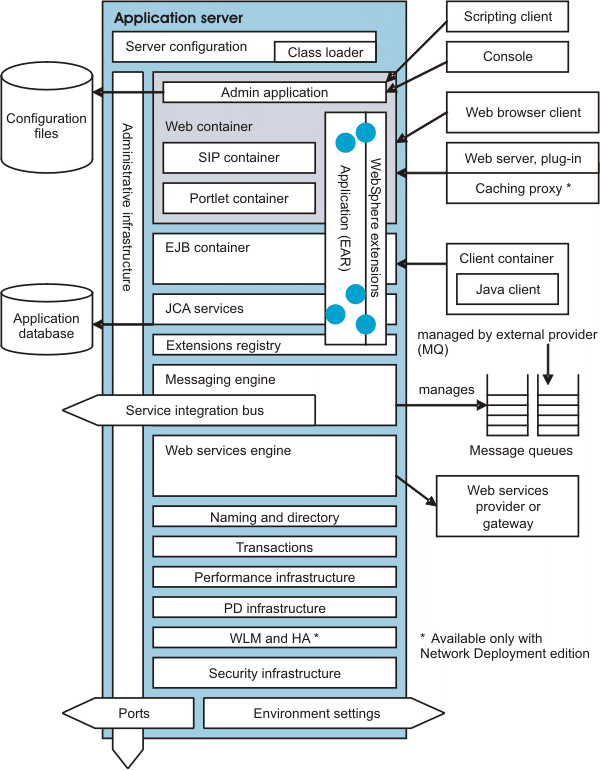Product architecture
Servers
An appserver is a JVM running user applications. Application servers use Java technology to extend Web server capabilities to handle Web application requests. An appserver makes it possible for a server to generate a dynamic, customized response to a client request.
The WAS product provides appservers.
In distributed platforms, you can use the generic servers feature to create a generic server as an appserver instance within the product administration, and associate it with a non-WebSphere server or process. The generic server can be associated with any server or process that is necessary to support the appserver environment.
The product supports messaging by providing a JMS Provider that conforms to the JMS Specification 1.1. On the single-server product, the JMS functions (of the JMS provider) for an appserver are served by the JMS server within the appserver.
In the ND product, the JMS functions (of JMS providers) within the administrative domain are served by one or more JMS servers.
In the WAS product, an appserver works with a Web server to handle requests for Web applications. The appserver and Web server communicate using an HTTP plug-in for the Web server.
Core groups and core group bridges.
A core group is a statically defined component of the high availability manager. The high availability manager is a product function that monitors the appserver environment and provides peer-to-peer failover of appserver components. A core group bridge is a configurable service for communication between core groups.
In the ND product, clusters and cluster members help you monitor appservers and manage the workloads of servers.
Environment settings
Cell-wide settings help handle requests among Web applications, Web containers, and appservers in a logical administrative domain called a cell.
A virtual host is a configuration enabling a single host machine to resemble multiple host machines. Resources that are associated with one virtual host cannot share data with resources associated with another virtual host, even if the virtual hosts share the same physical machine. Each virtual host has a logical name and a list of one or more DNS aliases by which it is known. A DNS alias is the TCP/IP host name and port number that are used to request the servlet... hostname:80.
Variables are used to control settings and properties relating to the server environment. WebSphere variables are used to configure product path names such as JAVA_HOME, cell-wide customization values, and the WAS for z/OS location service.
Shared libraries are files used by multiple applications. You can define a shared library at the cell, node, or server level. You can then associate the library to an application or server in order for the classes represented by the shared library to be loaded in either a server-wide or application-specific class loader.
Replication is a service that transfers data, objects, or events among appservers. Data replication service (DRS) is the internal WAS component that replicates data. Replication domains transfer data, objects, or events for session manager, dynamic cache, or stateful session beans among appservers in a cluster.
System administration
The console is a graphical interface that provides many features to guide you through deployment and systems administration tasks. Use it to explore available management options.
The WebSphere administrative (wsadmin) scripting program is a powerful, non-graphical command interpreter environment enabling you to run administrative operations in a scripting language. You can also submit scripting language programs to run. The wsadmin tool is intended for production environments and unattended operations.
Administrative programs (Java Management Extensions)
WAS supports a Java programming interface for developing administrative programs. All of the administrative tools that are supplied with the product are written according to the API, which is based on the industry standard JMX specification.
Command-line tools are simple programs that you run from an operating system command-line prompt to perform specific tasks, as opposed to general purpose administration. Using the tools, you can start and stop appservers, check server status, add or remove nodes, and complete similar tasks.
Product configuration data resides in XML files that are manipulated by the previously mentioned administrative clients.
Servers, nodes and node agents, cells, and the deployment manager are fundamental concepts in the administrative universe of the product. It is also important to understand the various processes in the administrative topology and the operating environment in which they apply.
Performance
Monitor tools.
Performance monitoring is an activity in which you collect and analyze data about the performance of your applications and their environments. Performance monitoring tools include:
- Performance Monitoring Infrastructure (PMI) for monitoring to understand overall system health.
- Request metrics for monitoring to understand resource usage.
- Tivoli Performance Viewer (TPV) for viewing the performance data that you collected.
Tuning the product helps you obtain the best performance from your Web site. Tuning the product involves analyzing performance data and determining the optimal server configuration. This determination requires considerable knowledge about the various components in the appserver and their performance characteristics. The performance advisors encapsulate this knowledge, analyze the performance data and provide configuration recommendations to improve the appserver performance. Therefore, the performance advisors provide a starting point to the appserver tuning process and help you without requiring that you become an expert.
Troubleshooting
Diagnostic tools help you isolate the source of problems. Many diagnostic tools are available for WAS.
IBM Support can assist in deciphering the output of diagnostic tools. Refer to the WAS Technical Support Web site for current information on known problems and their resolution. Documents at this site can save you time gathering information that is needed to resolve a problem.
Sub-topics
Three-tier architectures
